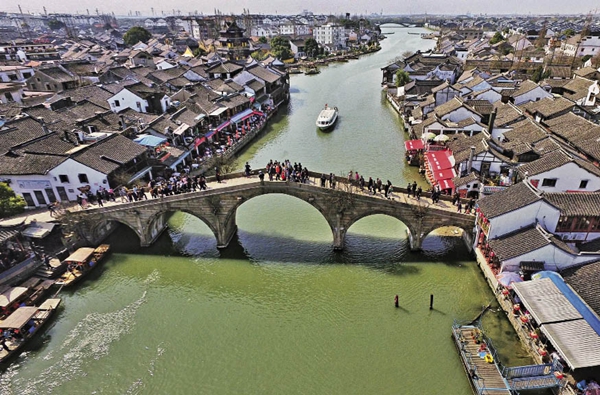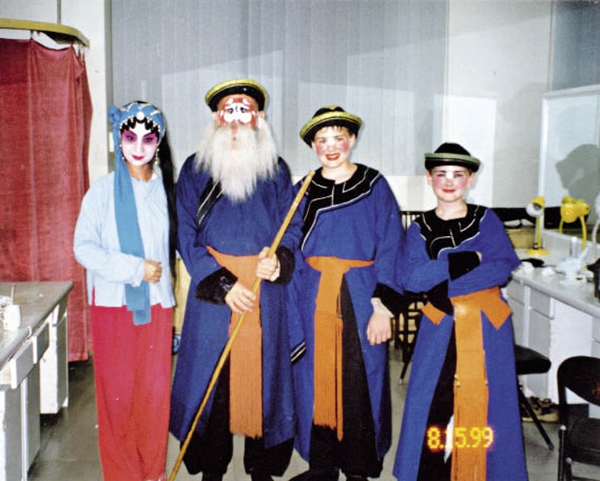I’VE had few experiences as bucolic as gliding downriver past weeping willows and under the 36 arched bridges of 1700-year-old Zhujiajiao Water Town – “Shanghai’s Venice of China.” Zhujiajiao is a Chinese painting come to life, with ancient white-washed tiled-roof homes adorned with classic red lanterns, 27 rivers teeming with fish, wildlife, and fowl such as egrets, wild mandarin ducks, and turtledoves, and the ruby red lotus flowers enshrined in ancient paintings and poems.
Today, this town with a population of 60,000 is a Chinese honeymooners’ paradise (and just as enchanting for those of us who have been honeymooning for decades). Whether taking a water taxi or strolling along ancient stone-paved streets past the restored Ming (1368-1644) and Qing (1644-1911) dynasty homes, you feel like you’ve wandered onto the set of a Chinese movie.
Shanghai folks once again boast, “Pudong is Shanghai’s decade of development; the Bund is Shanghai’s century of history; Zhujiajiao is Shanghai’s 1,000 years of culture.” But Zhujiajiao’s resurrection did not come cheaply.

A panoramic view of Zhujiajiao Water Town.
Between 2003 and 2008, the government spent US $300 million on purifying contaminated water and soil, developing the infrastructure, and reconstructing the old town. Zhujiajiao now has some 200 kinds of fish, as well as 40 bird species, thanks to 28,000 artificial nests placed in trees and on roofs.
The government removed 63 factories, hospitals, and government buildings and restored the Ming and Qing dynasty homes. Buildings beyond repair were reconstructed in the traditional style with white walls and roof tiles “grayed by time.” I marveled that I could not distinguish new buildings from ancient ones, but finally discovered their secret. Local craftsmen use traditional tools and techniques to meticulously restore old buildings or create new structures – even down to the intricate carvings in wood and stone. It looked so simple that I tried it myself. I was relieved that I’d taken a hammer and chisel to a scrap of rock instead of an actual relic because after two of my clumsy blows the stone cracked. I guess I’ll stick to teaching.
As in my own home of Xiamen, and back in the U.S. as well, private ownership of buildings complicates restoration, so the local government sets aside 10 to 15 percent of its annual development budget to purchase historical buildings. This relieves the original owners of the burden of both restoration and maintenance, which is much costlier than rebuilding from scratch.
Zhujiajiao’s restoration project is non-profit, and all admission fees are used strictly for maintaining the dozens of historic and cultural sites and registered historic landmarks.
Zhujiajiao softened some of its commercialism by pulling down 400-year-old Dabei (Great North) Street billboards and banning advertising in the historical zone. Some of the modern shops whose appearance clashed with the setting were replaced with tasteful antique shops and art galleries.
Zhujiajiao is famous not only for its ancient heritage but also for its role in the 1950s as a center of New China’s state granaries. Like many towns in the U.S. and Europe, Zhujiajiao preserved the granaries’ exteriors and transformed the interiors into venues for local traditional performances and cultural events. Repurposed industrial sites are a stark reminder not to take our affluence for granted.
Until the early 1990s, China strictly rationed everything from grain, meats, veggies and oil to petrol for cars. My wife and I prized ration coupons more than cash because we had little cash– and there was little to buy even when we had it.
Little Zhujiajiao has enough to keep one busy from dawn to dusk – quite literally. First order of the day is the ancient “morning tea” ritual, which has made a big comeback. Tea shops along the Caogang River open early and serve inexpensive morning tea to both locals and early-bird tourists. As in olden days, people share tables and leisurely sip tea while discussing the news, business or swapping tall tales.
After morning tea, we enjoy the water taxis or strolling along Great North Street, which is said to be “a mile long with 1,000 shops.” We also like the Daqing (Great Qing) Post Office on Xihu (West Lake) Street and Daxin Street’s old-time Tong Tian He Chinese Pharmacy.
When Zhujiajiao’s lanes get crowded (it’s becoming increasingly popular with Japanese tourists), it’s time to head for the quieter environs of the beautiful Kezhi Garden or Fangsheng Pavilion. And once the sun has set, the town offers a different kind of magic as the rivers reflect the countless red lanterns hanging from boats and buildings alike.
As in some historic towns back in the U.S., many of Zhujiajiao’s locals keep the past alive by wearing traditional costumes and engaging in such traditional activities as picking water chestnuts. Between the scenery, ancient architectures and the bright traditional costumes, the place really does resemble a movie set come to life – especially during the annual dragon boat races and Mid-Autumn Festival.
Like most places in China, Zhujiajiao is famous for its unique foods, including dark-rice zongzi (leaf-wrapped dumplings), Shanghai steamed dumplings (I love all kinds of Chinese dumplings, but Shanghai’s are unique), Dianshan Lake fresh water crabs, roasted soybeans, and rose-flavored fermented bean curd (which I’ve never seen anywhere else, though in West China, people use roses in cooking and wine-making).

Bill Brown and his two sons in Chinese opera costumes.
Every year in September or October, music fans from all over the world flock to Zhujiajiao to participate in the annual Water Village Music Festival and enjoy performances by both locals and popular bands from around the world. One local opera fan group consists of retirees of an average age of 70. And while most Chinese cities have English Corners, I’ve never heard of one with Song Corners. Visitors are often surprised to see groups as large as 300 people practicing singing. Zhujiajiao even has a shop where a man makes guqin (a seven-string musical instrument of the zither family) and also gives lessons. (My wife gave me a guzheng for our wedding in Taipei; I never did learn to play it but it looks cool in our living room!).
If you look a bit lost as you decide what to do next, don’t be surprised if a local offers suggestions in English or Japanese. The town has almost 4,000 volunteers, one fourth of whom have trained as volunteer foreign language tour guides. Zhujiajiao residents are proud of their town and keen to help visitors appreciate it as well.
Zhujiajiao is only an hour’s drive from Shanghai but you’ll probably ditch your car once you’ve arrived because cars are banned in most historical areas. The ban on cars adds to the old-world ambience and encourages use of the ubiquitous water taxis, which add an element of charm to the waterscape. But don’t worry! Every town entrance from the highway has a parking lot for cars and free bicycles for drivers.
So if you’re in Shanghai for either business or pleasure, don’t miss out on this “Venice of China.” Both the place and its people are one of a kind.
DR. BILL BROWN is a professor at the Xiamen University MBA Center and Academic Director of its OneMBA program.
